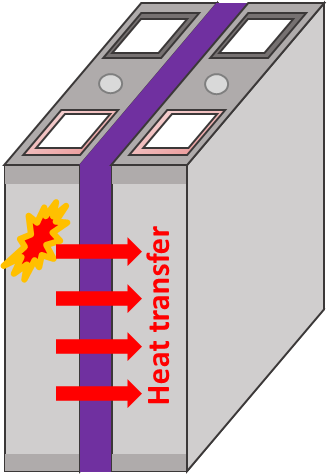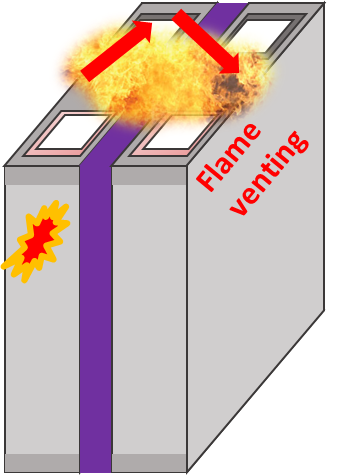Thermal runaway propagation
Thermal runaway in lithium-ion cells comes with an uncontrolled, exothermic release of energy within a few seconds. If a crash or a cell-internal fault causes the thermal runaway of a first cell in the battery pack, this will start a chain reaction in which the burning cells each infect their neighboring cells and set them on fire. This chain reaction is known as thermal runaway propagation. In large packs with many dozens or hundreds of cells, the result is a massive battery fire.

Thermal runaway propagation is the most critical safety issue in lithium-ion batteries. The good news is that we can prevent it with the right measures.
Marius Bauer, CEO
Mechanisms of thermal runaway propagation
Heat transfer via the side surfaces of the cells

During the thermal runaway of a first cell, temperatures of over 600°C are measured on its surface. This will drive heat transfer across the side surfaces of the cell. If the temperature of the neighboring cell exceeds a critical threshold, the separator inside it melts and it is also triggered into thermal runaway. In order to suppress thermal runaway propagation, heat transfer to the neighboring cells must be reduced drastically. This is achieved by putting highly effective thermal barriers in between the individual cells.
Hot gas and particle jets (Venting)
Hot gas jets and particle streams ejected from the first cell can bypass the thermal barrier and trigger neighboring cells. This represents a further mechanism for thermal runaway propagation. It can only be prevented by additional protective components (e.g. potting materials) and a suitable module design.

Additional failure modes
Lithium-ion packs are complex technical systems. A large number of design details can have a decisive influence on the performance of the module design during thermal runaway propagation. Depending on the intended module concept (cell format, interconnection, venting concept, mechanical structure of the modules), it is necessary to prevent a number of typical error mechanisms by taking appropriate measures.
Thermal runaway propagation and cell format
Large-format lithium-ion cells are offered and used in different form factors. The most important types are prismatic cells, pouch cells and round cells. Thermal runaway propagation occurs in battery systems of all cell formats if this is not prevented by suitable design measures.
